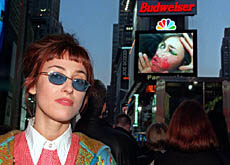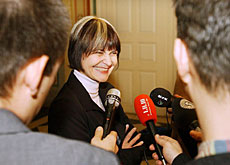Women seek bigger role on Swiss cultural stage

The uphill struggle for sex equality by Swiss women involved in the arts is closely examined in a new book published by Pro Helvetia - the arts council of Switzerland.
Written in English, it concludes that while great strides have been made in the past 30 years, in some respects there is still some way to go.
“The Cultural Role of Women in Switzerland” points out that in Switzerland – and elsewhere – the arts continue to be male-dominated.
“Women artists have not yet caught up completely,” it says. “Numerically speaking, in fields such as literature where they are well represented, they account for one-third, while the proportion of women orchestra musicians is no more than about one-fifth.”
The book puts the situation in its historical context, noting the parallels between the status of women in the arts and their position in society.
“Until the latter part of the 20th century a woman’s place tended to be in the home as a housewife,” its author, freelance journalist Isabel Morf, told swissinfo. “The only ones who worked had to, because they were poor and needed money.”
“Before the mid-20th century there were very few female fiction writers; maybe only five or six who are still remembered today,” she adds.
“But the advent of feminism and women’s lib in the early 1970s was like an explosion. Many new voices of female authors were heard and women’s bookshops were opened. Today they are no longer the exception, but the rule.”
Theatre
Morf speaks of a similar trend in the theatre: “The last three decades saw the arrival on the scene of free theatre groups in villages as well as towns and cities.
“They were free from traditional theatre structures and women were involved in them from the beginning.”
The long struggle for equality by women in the visual arts follows a similar pattern to that of their literary counterparts.
Morf writes that a comprehensive survey of Swiss art from 1890 to 1980 mentions 600 artists, of whom only 50 were female.
Since the 1980s there has been much less of an imbalance, while the number of art museums and public galleries run by women has sharply increased.
Performance art
Meanwhile, a recent trend shows that women find it easier to become established in the more contemporary artistic genres such as video and performance art, which are not shaped by a male tradition.
But in some respects, says Morf, much more progress is needed. Women conductors are rare in Switzerland – as elsewhere. This could be due to their minority presence in most orchestras.
Referring to the arts in general, she says that like in other professions, women have to find ways of balancing work and domestic life.
“In marriages between two artists, problems may arise if the wife is more successful than the husband,” she continues.
Better prospects
However, the picture painted by the book is far from gloomy when looking ahead to the future. Morf says the presence on the cultural scene of “token” women is fast disappearing.
She believes that so much is happening that every chapter of the book could easily have been expanded to twice or three times its length in her 116-page volume.
“If I have to work on another edition five years from now,” she says, “the book would look very different again. The changes are coming faster.”
“The Cultural Role of Women in Switzerland” is distributed abroad by Swiss diplomatic missions and available in Swiss bookshops.
This is the first English edition of the book; two editions have been published in German since 1997.
swissinfo, Richard Dawson
A comprehensive survey of Swiss art from 1890 to 1980 mentions 600 artists, only 50 of whom were female.
Numerically speaking, in fields such as literature where they are well represented, women account for one-third, while the proportion of women orchestra musicians is no more than about one-fifth.
A recent trend shows that women find it easier to become established in the more contemporary artistic genres such as video and performance art, which were not shaped by a male tradition.
Published by Pro Helvetia, “The Cultural Role of Women in Switzerland” is distributed abroad by Swiss diplomatic missions and available in Swiss bookshops.

In compliance with the JTI standards
More: SWI swissinfo.ch certified by the Journalism Trust Initiative

You can find an overview of ongoing debates with our journalists here. Please join us!
If you want to start a conversation about a topic raised in this article or want to report factual errors, email us at english@swissinfo.ch.